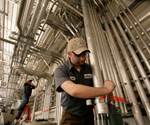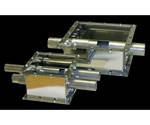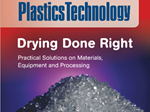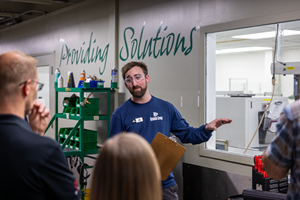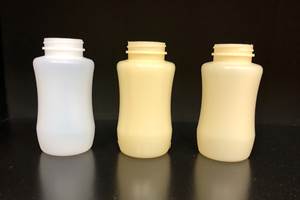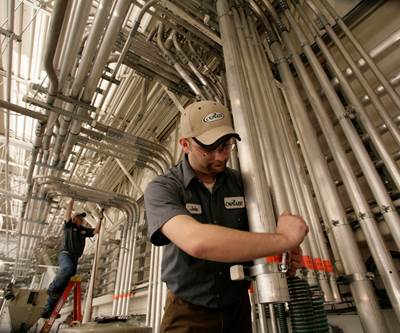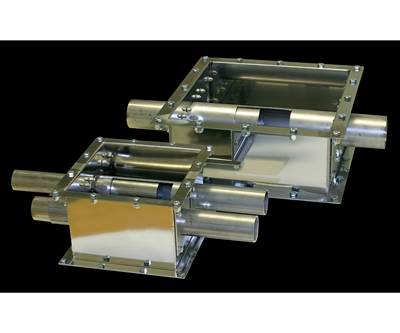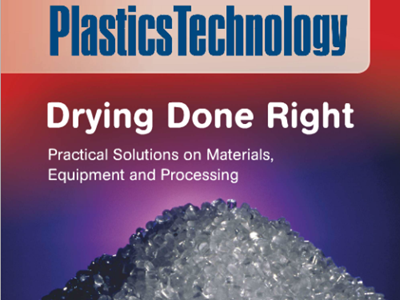Ever visited a medical molder that was especially proud of its piping? You might answer in the affirmative if you were a customer of the Flex facility in Manchester, Conn. “When installing our second central drying/conveying system, we focused on presentation and wanted the system to really show well, as it is front and center in our new building,” explains Cory Beaupre, lead automation engineer at the complex of four buildings that together comprise 142,000 ft2, with 350 employees and 70 injection molding machines from 35 to 500 tons.
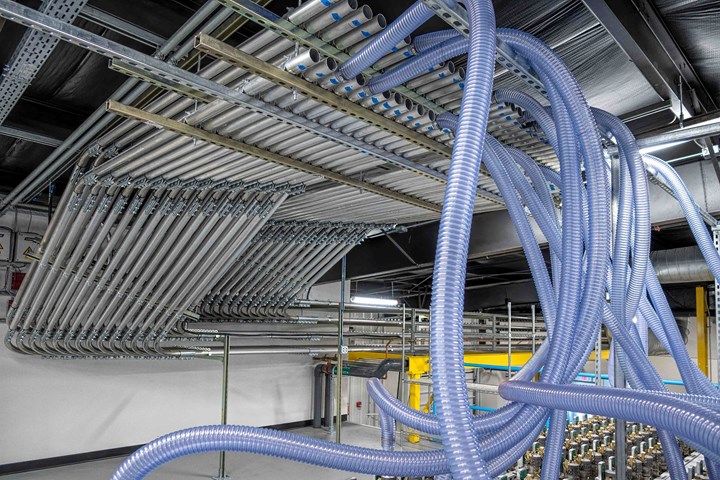
New materials-handling system from Wittmann Battenfeld conveys a clean look appropriate to the Flex medical molding business.
Adds Zachary (Zach) Brodeur, general manager of the Manchester operation, “Everything here is exposed for the customer to see. Everything is clean and well polished—even the pipes. No hiding things in closets behind closed doors.”
What they’re not hiding, but rather showing off, is a material-handling system installed in 2019 in Building 111 that is one of the largest ever built by Wittmann Battenfeld. It is one of several clever features of this plant’s design, including utilities layout, that was conceived for maximum flexibility.
‘Everything here is exposed for the customer to see. Everything is clean and well polished—even the pipes.’
Flex Relies on Flexibility
Manchester is one of more than 100 manufacturing and service sites in more than 30 countries where Flex serves a wide range of industries from automotive to medical to consumer appliances and electronics. Based in San Jose, Calif., the company (flex.com) employs around 160,000 worldwide and had revenues over $24 billion in its most recent fiscal year.
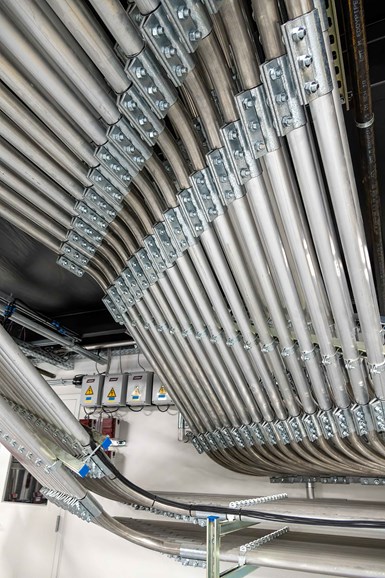
At full capacity, the material-handling system will involve around 5 miles of piping.
Flex Manchester is devoted entirely to medical components—high-volume disposables and components for surgical instruments, biosciences, and drug delivery (especially insulin). Most of the parts molded here are fist sized or smaller, down to 0.1 g. The plant’s specialties are high cavitation (up to 96), integrated automation, and two-shot molding, such as ABS/TPE or PC/PC in different colors or clear and opaque. The plant molds 2.25 million lb of materials, much of it PP but trending more toward engineering materials such as PC, glass-filled nylon, COC and LCP.
Manchester is growing rapidly, Brodeur notes, more than doubling in size since 2014. In April, 15 presses were delivered, and a 2000 ft2 packaging area is being converted to a cleanroom that will house two more machines.
The vast majority of the presses are all-electric, mostly Milacron-Fanuc Roboshot machines, on which the plant is standardizing for future growth. There are also some Engel presses and Sodick Plustech machines for micromolding. All machines are outfitted with three-axis Cartesian robots, more than 50 of them from Wittmann Battenfeld, including 15 purchased this year. Beaupre values these robots’ user-friendly operation and programming that is “fairly simple and straightforward.” He also praises Wittmann’s responsive customer service, noting that the firm’s U.S. headquarters is less than 40 miles away in Torrington, Conn.
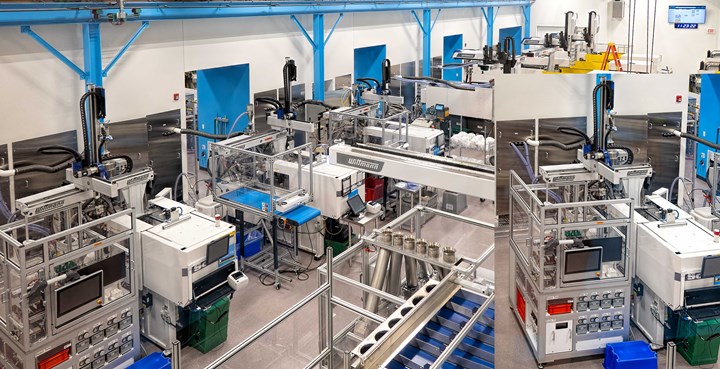
For an open, uncluttered layout of the plant’s clean room, utilities like water and power, as well as materials, are plumbed inside the walls to stainless-steel access plates at each injection machine (inset).
All but four of the injection machines at Manchester are in three cleanrooms, totaling 36,000 ft2. One strategy for keeping the cleanrooms clean is eliminating any utilities from the controlled environment. “Flex came to us asking for no plumbing or piping to be exposed in the cleanroom areas,” says Joe Norco Northeast regional sales manager for material handling and auxiliaries at Wittmann Battenfeld. “So the pipes were designed to run from the distribution manifold through the ceiling, then down through the walls, to a service area for each machine.” All water and electrical services also are plumbed inside the walls of the cleanroom, where a stainless-steel access module provides connections to the molding machine.
‘This building is designed for maximum flexibility.’
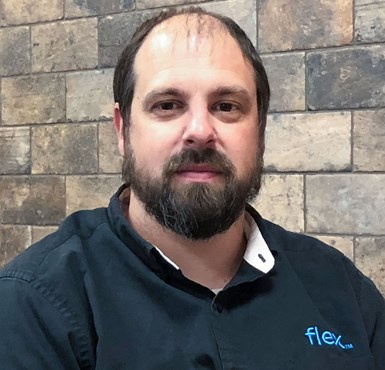
Cory Beaupre, lead automation engineer, was confident about the new handling system, as an earlier, smaller central system from Wittmann Battenfeld ran 24/7 since 2006 with no major repairs and very little unscheduled downtime.
“But we do not bury control or communications cables inside the wall, where they would be harder to get at,” notes Brodeur. He adds,“We have a unique approach to handling electricity. Our system allows us to divert any amount of power or voltage to any machine.” There are 30 machine bays in the 14,000-ft2 cleanroom of the 111 building. “So we can put any machine in any bay, whether 35 or 500 tons. We can provide sufficient power anywhere for our largest press with two-shot capability, a robot and integrated downstream automation. This is part of how we designed this building for maximum flexibility.”
Another key flexibility enabler is the new central material-handling system, supplied by Wittmann Battenfeld. Flex already had experience at Manchester with a smaller system from that company. According to Beaupre, “The reliability and durability of that system is battle tested, as it has been running nearly 24/7 since 2006 without any major refurbishment.”
Reinforcing that point, Brodeur notes that “we have experienced only 48 to 72 hr of unexpected downtime in that period with the first system, usually because of a power surge or dropped leg that damaged an electrical component.”
The new system in the 111 building was planned for capacity to serve all 30 injection machines intended for this building, but it is being installed in three phases, parallel with anticipated growth in molding business at the plant. “We did this for most efficient capital allocation and to keep equipment utilization high,” Brodeur explains.
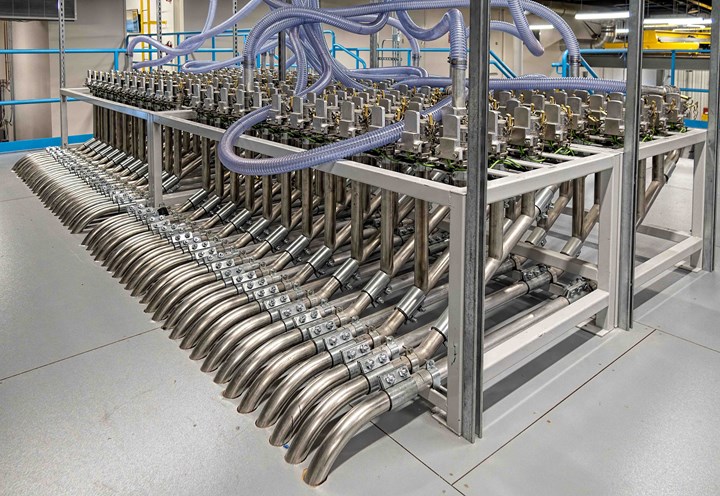
Heart of the plant’s materials supply this Wittmann materials distribution system with 192 connections, all RFID tagged for error proofing.
Now in Phase II, the plant has installed two Wittmann DryMax dryers (the third is on order) and two rows of 10 drying hoppers (with a third planned for Phase III), sufficient to serve 23 injection presses. Located on the same mezzanine level above the molding floor are five Wittmann XMB vacuum pumps, one of them a spare that would automatically come on line if one of the others failed. (“Being able to change over on the fly is important to us,” says Beaupre.) This pump capacity was installed in Phase I but is sufficient for Phases II and III. The system provides dilute-phase conveying from gaylords and bags. Components of the material-handling system equipment that generate heat and noise are isolated in a separate, soundproofed room with its own HVAC system.
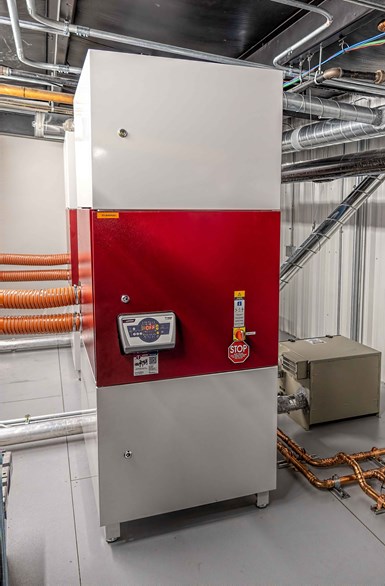
Currently in Phase II of its growth, the plant has two Wittmann DryMax central dryers, to which a third will be added in Phase III.
The heart of the drying/conveying setup is a central distribution system, as large or larger than any previously built by Wittmann Battenfeld. It has 200 connections to deliver raw materials to molding machines, including 15 for non-dried resins. These are all RFID tagged to ensure that the right material goes to the right machine. The whole drying and conveying system is regulated by a Wittmann M7.3 network control.
Norco says the system currently deploys 4 miles of piping and will expand to around 5 miles when Phase III is implemented. Aluminum piping is used on straight runs, with stainless-steel elbows to resist wear. Most notable is the clean, uncluttered layout of the piping in the mezzanine area that visitors must walk through to view the molding area through large windows.
“Wittmann provided very functional yet extremely elegant solutions for just a ‘material-handling system,’ says Beaupre. “We feel confident we can walk past the system with visitors and not be embarrassed by the piping layout. The attention to detail on installation is topnotch.”
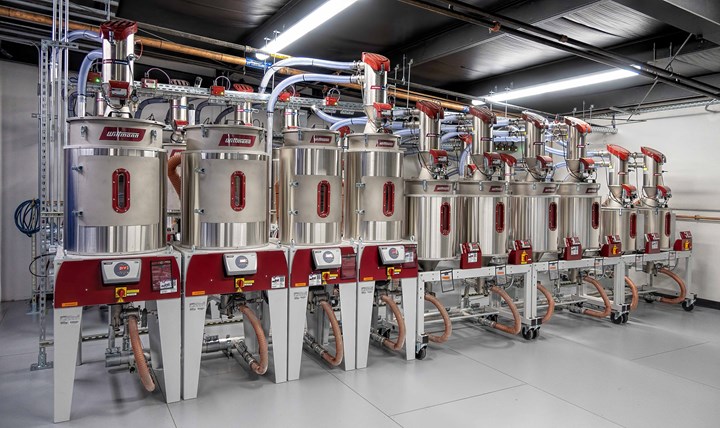
Two rows of 10 drying hoppers will be supplemented by a third row in Phase III of the plant’s growth.
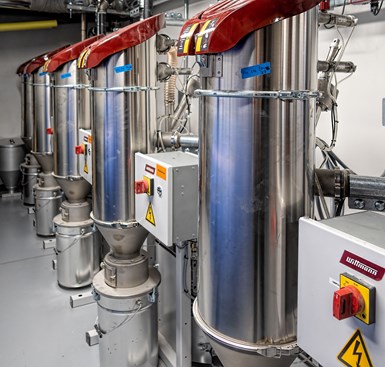
Five Wittmann XMB vacuum pumps include a spare that comes on automatically if one of the other pump fails.
Keeping Track of Production
The cleanrooms are monitored—some of them remotely—for air temperature and pressure, humidity and particulates. Every molding press is tied into a PLC that reports to a central MES/MRP system of a design standard to all Flex facilities. OEE (Overall Equipment Efficiency) statistics are posted to an online user dashboard, available 24/7 anywhere in the world. A large monitor on the wall of the molding cleanroom shows the floor personnel a display that alternates between machine status and OEE.
According to Brodeur, “The industry OEE average is 75%; the best world-class shops are at 85%. We averaged 81.2% in April and are at 89.5% today. We started with a goal of 75% OEE average, but we blew through that, so our goal today is 85%. We believe that’s achievable—Flex MCI (Mirror Controls International) in Europe, (serving automotive) hits a 93% OEE average regularly.”
Related Content
Impacts of Auto’s Switch to Sustainability
Of all the trends you can see at NPE2024, this one is BIG. Not only is the auto industry transitioning to electrification but there are concerted efforts to modify the materials used, especially polymers, for interior applications.
Read MoreMedical Molder, Moldmaker Embraces Continuous Improvement
True to the adjective in its name, Dynamic Group has been characterized by constant change, activity and progress over its nearly five decades as a medical molder and moldmaker.
Read MoreMultilayer Solutions to Challenges in Blow Molding with PCR
For extrusion blow molders, challenges of price and availability of postconsumer recycled resins can be addressed with a variety of multilayer technologies, which also offer solutions to issues with color, processability, mechanical properties and chemical migration in PCR materials.
Read MoreHow to Extrusion Blow Mold PHA/PLA Blends
You need to pay attention to the inherent characteristics of biopolymers PHA/PLA materials when setting process parameters to realize better and more consistent outcomes.
Read MoreRead Next
How to Maximize Your Conveying System Performance
If your conveying system isn’t up to snuff, and you don’t have the budget to overhaul or expand it, don’t lose hope. There are many factors that could be limiting your conveying performance, and a number of them cost little or nothing to fix.
Read MoreFollow These Steps to More Efficient Central Pneumatic Conveying
Depending on when you bought and installed it, there are ways to tweak your central pneumatic conveying system to improve its performance and save you some money.
Read MorePlastics Technology's Drying Supplement
Learn from the experts, including savvy processors, on how to get drying done right.
Read More


